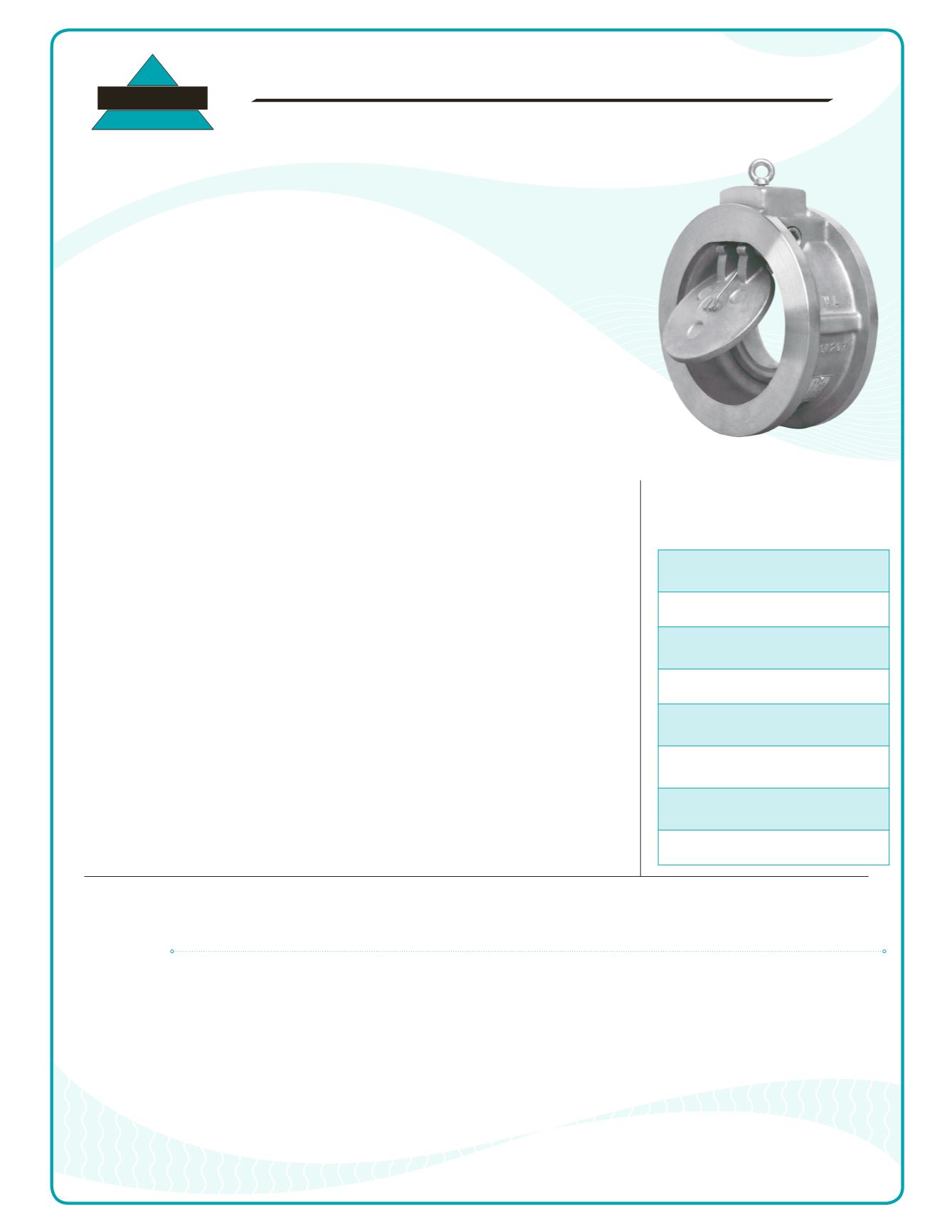

SWING CHECK VALVE
f
WAFER TYPE
f
SINGLE DISC
ANSI CLASS
150
f
CARBON AND STAINLESS STEEL
CV32-0617
T
TECHNICAL
TITAN
TITAN FLOW CONTROL, INC.
F
FEATURES
Tel: 910-735-0000
s
Fax: 910-738-3848
s
titan@titanfci.coms
www.titanfci.com290 Corporate Drive
s
PO Box 7408
s
Lumberton, NC 28358
YOUR PIPELINE TO THE FUTURE!
TITAN FLOW CONTROL, INC.
s
economi cal
des ign
low
we i ght
and
short
lay i ng
l ength
p roduce
s av i ngs
i n
i n i t i al
cos t
,
s pace
r equ i r ement s
,
and
i ns tal lat i on
when
compar ed
to
ful l
-
body
,
swi ng
-
ty p e
check
valv e s
.
s
minimal
head
loss
head
los s
i s
m i n i m i zed
by
p rov i d i ng
a
short
,
s tra i ght
and
v i rtual ly
unob s truct ed
f low
path
.
add i t i onal ly
,
the
s p r i ng
-
loaded
d i sc
i s
de s i gned
wi th
v e ry
low
crack i ng
p r e s sur e
wh i ch
r educe s
the
amount
of
ene rgy
r equ i r ed
to
op en
the
valv e
.
s
qui ck
closure
to
reduce
water
hammer
shut
-
of f
i s
ach i e v ed
v i a
the
ful ly
automat i c
,
s p r i ng
-
a s s i s t ed
d i sc
that
clos e s
near
ze ro
f low
v e loc i ty
.
the
l i ghtwe i ght
,
s i ngl e
d i sc
de s i gn
cr eat e s
a
pos i t i v e
shutof f
p r i or
to
f low
r e v e r s al
wh i ch
he l p s
to
ke e p
surge s
to
a
m i n i mum
.
s
durable
,
high
qual i ty
des ign
the
cv32 check
valv e
i s
ava i lab l e
i n
e i the r
carbon
s t e e l
or
s ta i nl e s s
s t e e l
body
conf i gurat i ons
,
wh i ch
al low
i t
to
p e r form
we l l
i n
h i ghe r
t emp e ratur e
ap p l i cat i ons
.
the
carbon
s t e e l
un i t s
ar e
e poxy
pa i nt ed
.
add i t i onal ly
,
both
mode l s
f eatur e
ant i
-
corros i v e
,
s ta i nl e s s
s t e e l
tr i m
(
d i sc
,
s p r i ng
,
sha f t
)
a s
s tandard
.
s
res i l i ent
soft
seats
r e s i l i ent
sof t
s eat s
(
v i ton
and
p t f e
o
-
r i ng
)
coup l ed
wi th
p r ec i s i on
mach i ned
s eal i ng
sur face s
he l p
to
ensur e
a
bub b l e
t i ght
s eal
that
me e t s
or
exce eds
ap i
598
t e s t
r equ i r ement s
.
A
APPLICATIONS
MODELS: CV 32-CS
(Carbon - Vi ton)
CV 32-SS
( S t a i n l es s - PTFE)
S IZES : 2" ~ 12"
PRESSURE/ TEMPERATURE RATING
CS - ASTMA216 G
r
.WCB - CLASS 150
WOG
(Non-shock)
: 285 PSI @ 100 °F
PRESSURE/ TEMPERATURE RATING
SS - ASTMA351 G
r
. CF8M - CLASS 150
WOG
(Non-shock)
: 275 PSI @ 100 °F
SEAT MATERIAL (O-RING)
TEMPERATURE RANGE
VITON: -40 ~ 400 °F
PTFE: 14 ~ 248 °F
SPRING MATERIAL
MAXIMUMTEMPERATURE
Series 300 Stainless Steel: 450 °F
markets
:
general
industry
,
chemical
,
petrochemical
,
power
,
and
food
&
beverage
service
:
intended
for
liquid
service
that
is
steady
,
clean
(
no
abrasives
or
solids
)
and
non
-
pulsating
.
flow
rate
should
not
exceed
15
ft
/
sec
.
not
recommended
for
steam
or
reciprocating
compressor
service
.
ptfe
properties
:
recommended
for
most
chemical
environments
including
acids
,
b ases
,
oils
,
steam
and
other
process
fluids
.
offers
excellent
tear
,
abrasive
,
chemical
,
acid
,
and
alkali
resistance
.
not
recommended
for
high
pressure
steam
or
large
temperature
variation
applications
.
viton
properties
:
offers
a
broad
range
of
chemical
resistance
and
excellent
heat
resistance
.
good
mechanical
properties
and
compression
set
resistance
.
often
used
in
applications
where
nothing
else
will
work
.
fair
low
temperature
resistance
and
limited
hot
-
water
resistance
and
shrinkage
.
The above data represents common market and service applications. No representation or guarantee, expressed or implied, is given due to the numerous
variations of concentrations, temperatures and flow conditions that may occur during actual service.


















